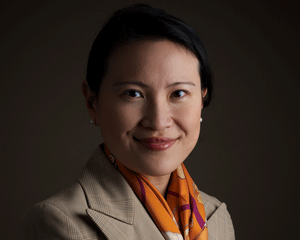Introducing Debbie Choy Grage: Women At Work

I am not sure what saddens me more – the statistics for women leaders in the US, or the statistics for Asian Americans in Corporate America. In Fortune 500 companies today, there are only 12 female CEOs – comprising 2.4% of this elite group. In Fortune 500 board rooms, only 16.1% of the board seats are occupied by female directors.
The numbers for Asian Americans in Corporate America are no less abysmal. Although the recent Pew Report cited the breathtaking growth of the Asian population in the US, they forgot to point out that out of over 18 million Asian Americans, only 9 of them are CEOs in Fortune 500 companies. Although representing almost 6% of the US population, only 2.1% of Fortune 500 board seats are being held by Asian Americans.
To be fair, the numbers cited above continue to improve year after year. For millions of Asian American professionals, life is better than it has ever been. But for the other tens of thousands who bump up against stereotypes of Asian Americans in the workplace, who are not given adequate recognition for their contributions, and who are passed over for promotions because they are not perceived as ‘strong enough’ leaders, these numbers offer validation of what they have long suspected but seldom articulate. This underrepresentation of a highly educated, motivated, industrious population may not be an isolated or circumstantial anomaly.
Although it is far easier to ignore these issues and let the political activists shoulder the fight, continued apathy by the larger Asian American community will result in one or both of two things –
- Asian American advancement in American society will stall or even decline; and/or
- our children’s world will be no better or even worse than our own.
Take a look at gender equality. Female advancement up the ranks of Corporate America has stalled, as fewer and fewer young women want to be associated with the ‘feminist’ movement, much less the word ‘feminist’. Does being a ‘feminist’ just mean having choices? A funny thing happened to women on our way to the C-suite – we forgot where we were heading.
Just as there is an economic cost to the under-utilization of women’s skills and capabilities – most of whom are educated at public expense – the systemic undervaluing of Asian Americans has a cost for mainstream America. As the industrialized economies continue to stall, Asian economies continue to power on. Asian Americans are in a unique position to help American companies enter Asian economies, and bridge the cultural gap to reach Asian consumers. Yet, our language, cultural, and leadership skills are seldom fully tapped, as many American companies prefer to install ‘one of their own’ (a.k.a. Caucasian males) in their Asian outposts. The trend seems to be that more white American managing directors are learning to speak Mandarin, instead of more Asian American executives stepping into the limelight. When educated, well-trained, and able-bodied employees become disenfranchised, innovation and productivity suffers. These are things that the US economy can ill-afford to be short of these days.
This column is about the Asian American woman in the workplace.
Women face powerful structural challenges in the US workplace today, which I shall discuss in this column. I shall also discuss the equally formidable barriers that Asian Americans face in the form of persistent stereotypes and how we are portrayed by public media and politicians. This column will explore issues like the motherhood penalty, structural challenges to work-family balance, opting out versus being pushed out, and the bamboo ceiling – all with a focus on the Asian American female perspective. It is my hope that by calling attention to these issues, we are more cognizant of how larger socio-economic themes that seemingly do not affect us can actually shape our everyday lives.
After years in Corporate America, I saw many Asian Americans – and women – bury their heads in the sand at work, laboring under the belief that doing good work would get them noticed by senior management. I understand the mindset. Like them, I was brought up to believe in meritocracy. So ingrained is this belief, that it can be confusing when promotions and raises are not based simply on merit. It gets even more confusing when managers encourage the notion that the workplace is meritocratic. After all, who would do the work if everyone was busy posturing?
At business school, we were taught that ‘heads-down’ is exactly what we should not do as leaders. Without altogether dispelling the myth of a meritocratic workplace, we were encouraged to think about how we could stand up and lead change in organizations. This is what I want to encourage Asian American women to do. Rather than focus on why we did not get the promotion or the raise that we wanted, let’s focus instead on how we can be more visible leaders in our organizations. Perhaps this can give us the recognition that we deserve.
As a Managing Editor of ALIST, I help to identify outstanding Asian American leaders who are changing the way that Asian Americans are perceived in Corporate America, the media, fashion, the arts, and other fields.
We tell their stories so that other Asian American leaders know that they are not alone, no matter how big or small the role.
Yes, change can take a lifetime to happen. But, if we do not start now, then when? If not us, then who?
If we want to change America, we have to lead it.
Welcome to ALIST.






